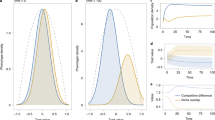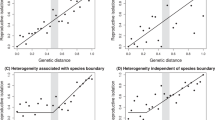Abstract
Empirical data indicate that sexual preferences are critical for maintaining species boundaries1,2,3,4, yet theoretical work has suggested that, on their own, they can have only a minimal role in maintaining biodiversity5,6,7,8,9. This is because long-term coexistence within overlapping ranges is thought to be unlikely in the absence of ecological differentiation9. Here we challenge this widely held view by generalizing a standard model of sexual selection to include two ubiquitous features of populations with sexual selection: spatial variation in local carrying capacity, and mate-search costs in females. We show that, when these two features are combined, sexual preferences can single-handedly maintain coexistence, even when spatial variation in local carrying capacity is so slight that it might go unnoticed empirically. This theoretical study demonstrates that sexual selection alone can promote the long-term coexistence of ecologically equivalent species with overlapping ranges, and it thus provides a novel explanation for the maintenance of species diversity.
This is a preview of subscription content, access via your institution
Access options
Subscribe to this journal
Receive 51 print issues and online access
$199.00 per year
only $3.90 per issue
Buy this article
- Purchase on Springer Link
- Instant access to full article PDF
Prices may be subject to local taxes which are calculated during checkout




Similar content being viewed by others
References
Eberhard, W. G. Sexual Selection and Animal Genitalia (Harvard Univ. Press, 1985)
Seehausen, O. & van Alphen, J. J. M. Can sympatric speciation by disruptive sexual selection explain rapid evolution of cichlid diversity in Lake Victoria? Ecol. Lett. 2, 262–271 (1999)
Gray, D. A. & Cade, W. H. Sexual selection and speciation in field crickets. Proc. Natl Acad. Sci. USA 97, 14449–14454 (2000)
Wilson, A. B., Noack-Kunnmann, K. & Meyer, A. Incipient speciation in sympatric Nicaraguan crater lake cichlid fishes: sexual selection versus ecological diversification. Proc. R. Soc. Lond. B 267, 2133–2141 (2000)
Turner, G. F. & Burrows, M. T. A model of sympatric speciation by sexual selection. Proc. R. Soc. Lond. B 260, 287–292 (1995)
Panhuis, T. M., Butlin, R., Zuk, M. & Tregenza, T. Sexual selection and speciation. Trends Ecol. Evol. 16, 364–371 (2001)
van Doorn, G. S., Dieckmann, U. & Weissing, F. J. Sympatric speciation by sexual selection: a critical reevaluation. Am. Nat. 163, 709–725 (2004)
Johansson, J. & Ripa, J. Will sympatric speciation fail due to stochastic competitive exclusion? Am. Nat. 168, 572–578 (2006)
Weissing, F. J., Edelaar, P. & van Doorn, G. S. Adaptive speciation theory: a conceptual review. Behav. Ecol. Sociobiol. 65, 461–480 (2011)
Schluter, D. The Ecology of Adaptive Radiation (Oxford Univ. Press, 2000)
Fisher, R. A. The Genetical Theory of Natural Selection (Clarendon Press, 1930)
Lande, R. Models of speciation by sexual selection on polygenic traits. Proc. Natl Acad. Sci. USA 78, 3721–3725 (1981)
Lande, R. Rapid origin of sexual isolation and character divergence in a cline. Evolution 36, 213–223 (1982)
Kirkpatrick, M. Sexual selection and the evolution of female choice. Evolution 36, 1–12 (1982)
Seger, J. Unifying genetic models for the evolution of female choice. Evolution 39, 1185–1193 (1985)
Payne, R. J. H. & Krakauer, D. C. Sexual selection, space, and speciation. Evolution 51, 1–9 (1997)
Mallet, J. Hybridization, ecological races and the nature of species: empirical evidence for the ease of speciation. Phil. Trans. R. Soc. B 363, 2971–2986 (2008)
Mallet, J., Meyer, A., Nosil, P. & Feder, J. L. Space, sympatry and speciation. J. Evol. Biol. 22, 2332–2341 (2009)
Barton, N. H. & Hewitt, G. M. Analysis of hybrid zones. Annu. Rev. Ecol. Syst. 16, 113–148 (1985)
Barton, N. H. & Hewitt, G. M. Adaptation, speciation and hybrid zones. Nature 341, 497–503 (1989)
Dieckmann, U. in Adaptive Speciation (eds Dieckmann, U., Metz, J. A. J., Doebeli, M. & Tautz, D. ) 306–307 (Cambridge Univ. Press, 2004)
Seehausen, O., van Alphen, J. J. M. & Witte, F. Cichlid fish diversity threatened by eutrophication that curbs sexual selection. Science 277, 1808–1811 (1997)
Hollocher, H., Ting, C., Pollack, F. & Wu, C. Incipient speciation by sexual isolation in Drosophila melanogaster: variation in mating preference and correlation between sexes. Evolution 51, 1175–1181 (1997)
Feulner, P. G. D., Kirschbaum, F. & Tiedemann, R. Adaptive radiation in the Congo River: an ecological speciation scenario for African weakly electric fish (Teleostei; Mormyridae; Campylomormyrus). J. Physiol. (Paris) 102, 340–346 (2008)
Ryan, M. J. & Wilczynski, W. Coevolution of sender and receiver: effect on local mate preference in cricket frogs. Science 240, 1786–1788 (1988)
Tregenza, T., Pritchard, V. L. & Butlin, R. K. The origins of premating reproductive isolation: testing hypotheses in the grasshopper Chorthippus parallelus . Evolution 54, 1687–1698 (2000)
Acknowledgements
We thank J. S. Brown, R. G. FitzJohn, D. E. Irwin, J. Ohlberger, J. L. Payne, A. Pomiankowski and G. S. van Doorn for discussions. Funding was provided by a Natural Sciences and Engineering Research Council (Canada) grant to L.K.M. (CGS-D) and S.P.O. (Discovery Grant). L.K.M. received additional support from the European Science Foundation Research Networking Programme ‘Frontiers of Speciation Research’. R.M. and U.D. gratefully acknowledge support by the Vienna Science and Technology Fund (WWTF). U.D. received additional financial support from the European Commission, the European Science Foundation, the Austrian Science Fund and the Austrian Ministry of Science and Research.
Author information
Authors and Affiliations
Contributions
U.D. and L.K.M. conceived this project. L.K.M., R.M., S.P.O. and U.D. discussed and designed the model. L.K.M. implemented the model with input from R.M., analysed the results together with R.M., S.P.O. and U.D. and prepared the manuscript. L.K.M., R.M., S.P.O. and U.D. jointly edited the manuscript.
Corresponding author
Ethics declarations
Competing interests
The authors declare no competing financial interests.
Additional information
Program code is available at http://www.zoology.ubc.ca/prog/coexist.
Supplementary information
Supplementary Information
This file contains Supplementary Text and Data, Supplementary Table 1, Supplementary Figures 1-9 and additional references. (PDF 550 kb)
Rights and permissions
About this article
Cite this article
M’Gonigle, L., Mazzucco, R., Otto, S. et al. Sexual selection enables long-term coexistence despite ecological equivalence. Nature 484, 506–509 (2012). https://doi.org/10.1038/nature10971
Received:
Accepted:
Published:
Issue Date:
DOI: https://doi.org/10.1038/nature10971
This article is cited by
-
Genomic evidence for three distinct species in the Erebia manto complex in Central Europe (Lepidoptera, Nymphalidae)
Conservation Genetics (2023)
-
A stochastic model for speciation by mating preferences
Journal of Mathematical Biology (2018)
-
Functional plasticity in vertebrate scavenger assemblages in the presence of introduced competitors
Oecologia (2018)
-
On Reciprocal Causation in the Evolutionary Process
Evolutionary Biology (2018)
-
A Stochastic Model for Reproductive Isolation Under Asymmetrical Mating Preferences
Bulletin of Mathematical Biology (2018)
Comments
By submitting a comment you agree to abide by our Terms and Community Guidelines. If you find something abusive or that does not comply with our terms or guidelines please flag it as inappropriate.



